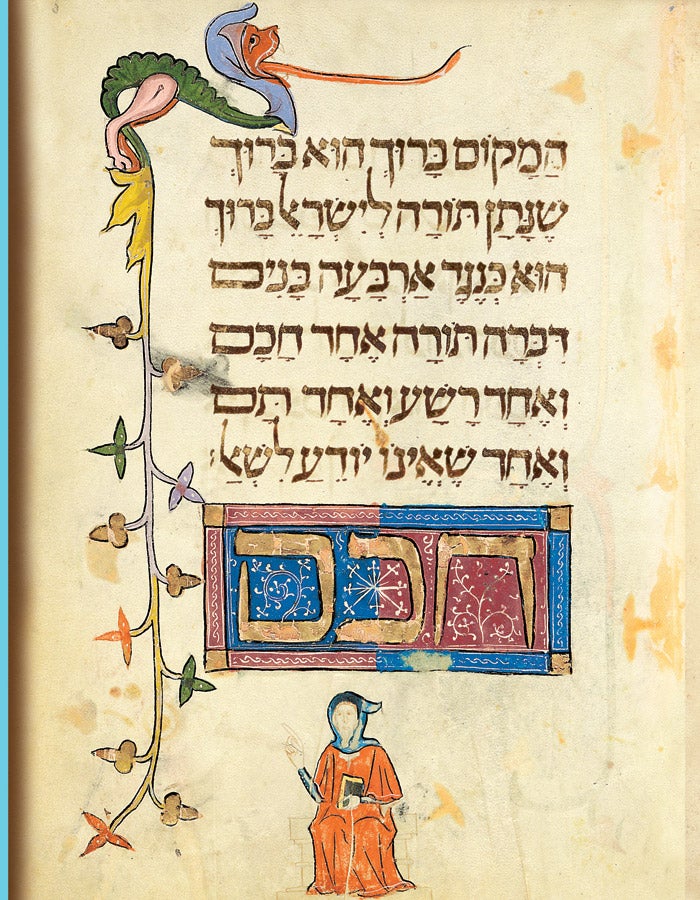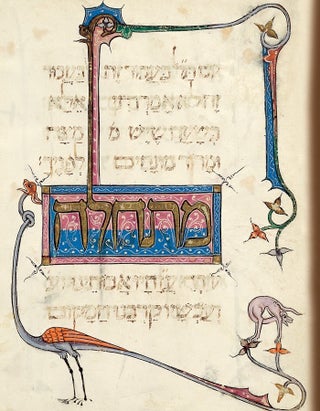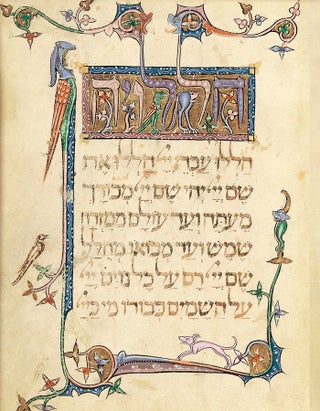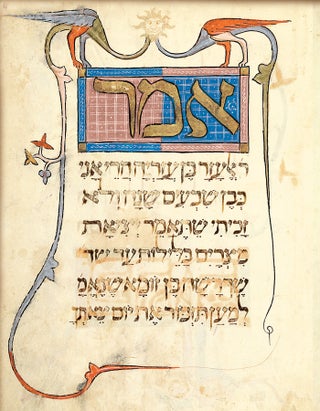THE PRATO HAGGADAH.
2006 (ca. 1300). Item #31324
8vo; Full leather, 14 x 21 cm, 160 pp + commentary. Unbelievably rich and extraordinarily refined in its artistic decoration, the Prato Hagadah was produced in Spain around 1300 C.E., with incomplete period illuminations and then with additions from the following three centuries. Folios 1-53 are in square Sephardic script, while folios 54-68 display a square Italo-Ashkenazic script. The hagadah includes 40 miniatures illuminated in gold and silver and 60 which are partially illuminated or only drawn. The Hagadah was featured in the Met's 2009 Exhibit, "Pen and Parchment: Drawing in the Middle Ages." Scholars at JTSA note that, “Nothing at all is known of either the patron or scribe of the Prato Haggadah, and little is known of its whereabouts from the time it was produced in Spain, around 1300, until the time it was acquired by the JTS Library in 1964. While the haggadah's text is written in accordance with the Spanish rite, at some point additional text, which included liturgical poems of the Ashkenazic rite, was added, most likely in Italy." "A 1617 signature of an Italian church censor, Giovanni Domenico Carretto is proof that the manuscript actually was in Italy at the beginning of the seventeenth century. Nothing further is known of the haggadah's history until 1928, when it was in the possession of Dr. Ludwig Pollak, a native of Prague living in Rome." The art of the Prato Haggadah is witty and creative. It includes many initial word panels, foliate ornamentation, and hybrid figures. Several illustrations relate directly to the text. The Haggadah contains motifs common in medieval manuscripts, and many folios reflect the artist's sense of humor.For unknown reasons, the manuscript's illumination was never completed. It is this unfinished nature of the work that allows the viewer to see the stages of production of an illuminated manuscript: the scribal arrangement of the text; the artist's preparatory drawings; the application of gesso to cushion gold or silver leaf; the addition of the leaf; the painting of a wide variety of pigments; and the outlining of the illuminations with ink. The text of the Prato Haggadah is also distinctive. Although it includes the standard biblical, talmudic, and midrashic texts, as well as the liturgical poetry common to other Spanish Haggadot, the Prato Haggadah lacks all elements associated with the Passover meal. Kiddush, blessings for matzah and maror, instructions for the feast itself, and grace after meals are absent. Scholars have suggested that Haggadot of this kind may have been written to be read publicly in the synagogue, after which people would return to their homes for the meal. This phenomenon is found in other Spanish Haggadot and is explained by medieval sources as satisfying the requirement to recount the story of the Exodus for people unable to lead or attend a seder. Many Sephardic Jews immigrated to Italy following the expulsions from the Iberian Peninsula at the end of the fifteenth century, often taking their manuscripts with them. The Prato Haggadah contains many textual changes and corrections inserted over several centuries. Though the Spanish or Ashkenazic sections of the manuscript cannot be definitively dated or localized, scribal practices and liturgical variants provide a general overview of the history of the manuscript and its owners (JTS, 2010). Printed and bound as an exact replica of the highest quality of the 13th Century illuminated manuscript in appropriate leather boards and parchment-like leaves and housed in a custom slipcase. Included is a companion volume, "The Prato Haggadah," (107 pages, with color illustrations) edited by Naomi M. Steinberger and with an introduction by David Kraemer, with essays and bibliographical references. Limited edition of 250 numbered copies. A treasure to behold.
Price: $4,700.00








